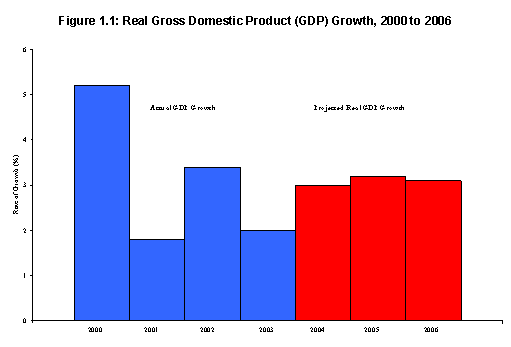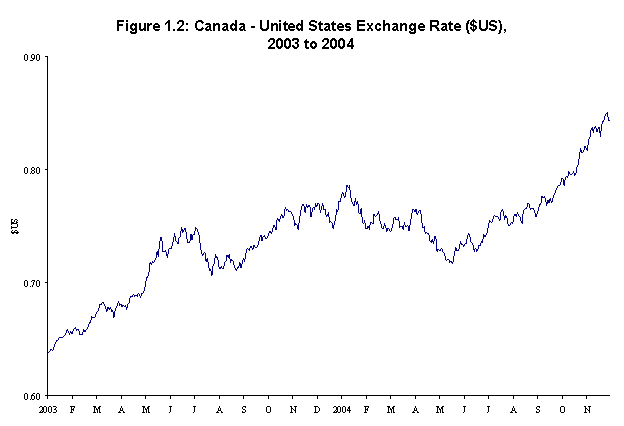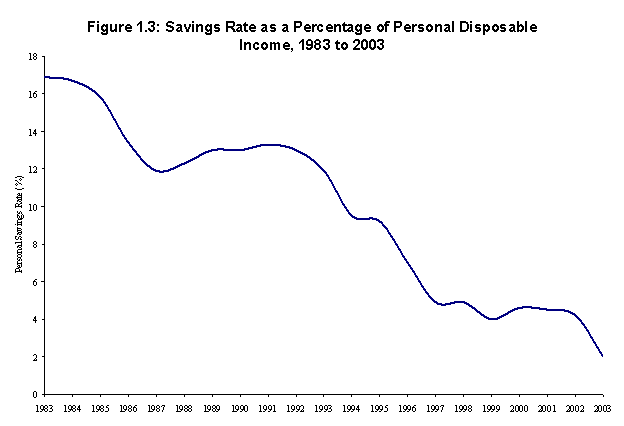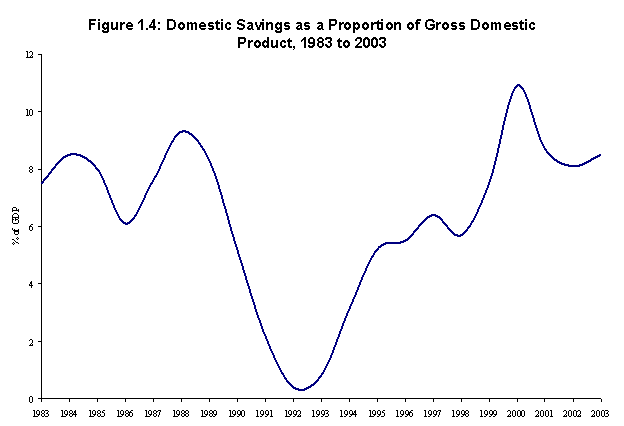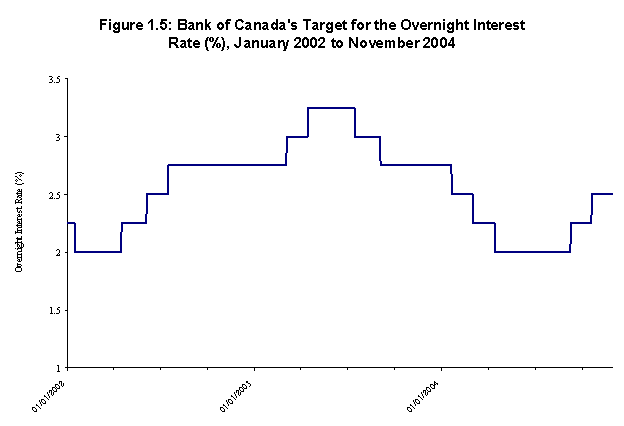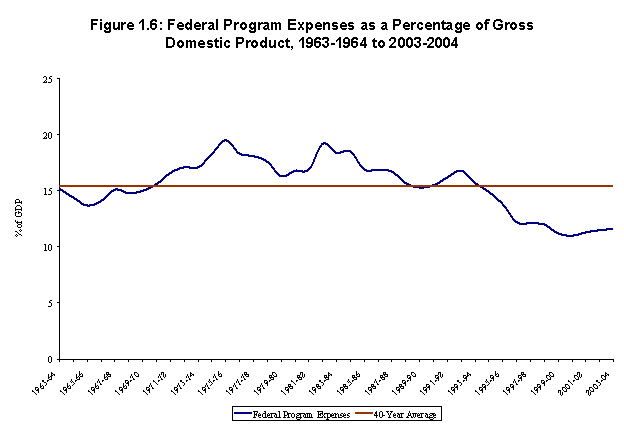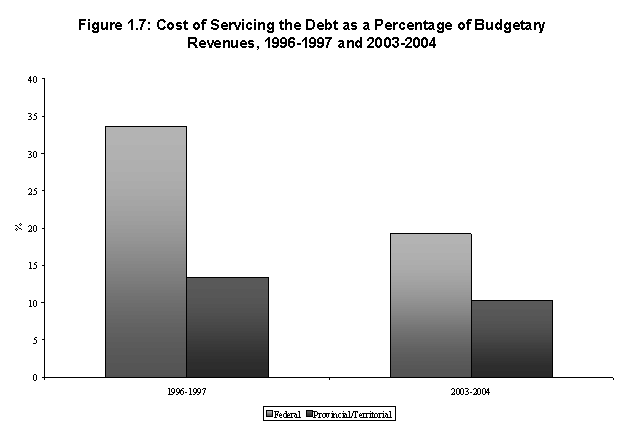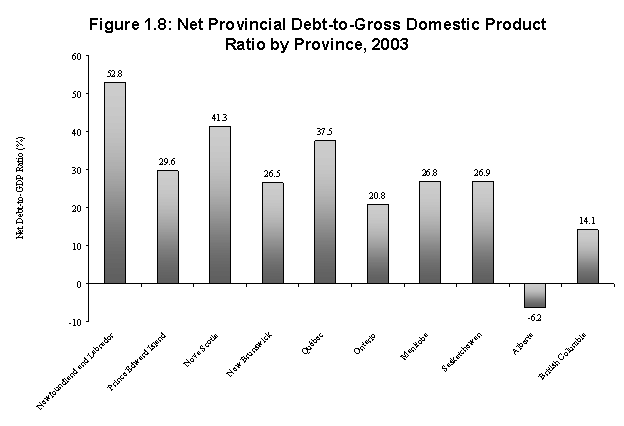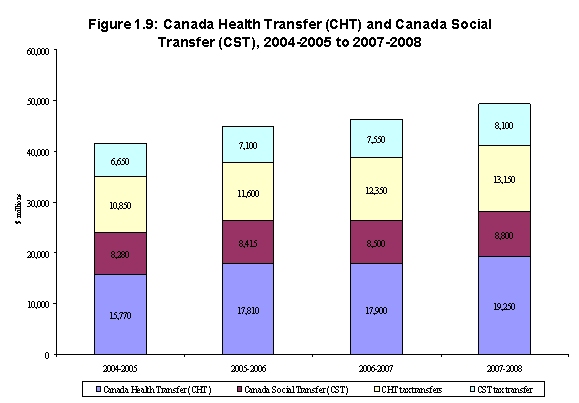FINA Committee Report
If you have any questions or comments regarding the accessibility of this publication, please contact us at accessible@parl.gc.ca.
THE CURRENT ECONOMIC SITUATION
A. What the Federal Government Provides
The federal government plays an important role in contributing to an environment in which businesses can grow and prosper and citizens can maximize their potential and opportunities. Through its spending, taxation and other policies, the government establishes the parameters within which businesses and citizens can thrive.
The 2004 federal budget reported that private sector economists expected Canada’s real economic growth rate to average 2.7% in 2004; to date, real Gross Domestic Product (GDP) grew by 2.7% in the first quarter of 2004, 3.9% in the second quarter and 3.2% in the third quarter (annualized rates). In his 16 November 2004 appearance before the House of Commons Standing Committee on Finance to provide an economic and fiscal update, the Minister of Finance indicated that GDP growth was almost 3.4% in the first half of 2004. Moreover, he said that private sector economists expect growth to be 3.0% in 2004 — an increase from 2.7% predicted in the 2004 budget — and to be 3.2% in 2005. Figure 1.1 shows GDP growth, both actual and projected, over the 2000 to 2006 period.
| Sources: | Statistics Canada and Department of Finance, Economic and Fiscal Update 2004, p. 68. |
Between 1997 and 2003, Canada led the G-7 countries in terms of real economic growth per capita.1 This performance is largely the result of Canada’s strong employment growth over the period, as Canada’s rate of employment grew at a pace more than twice the average of the other G-7 countries.2 In November 2004, the unemployment rate was 7.3% (seasonally adjusted).3
During the past year, the Canadian economy has been affected by the relatively rapid rise in the value of the Canadian dollar when compared to the U.S. dollar — the relative value rose 17% from January to December 2003 — and by the slow recovery in the U.S. economy in the first half of 2003. Since January 2004, the value of the Canadian dollar has continued to rise relative to its U.S. counterpart, consistently closing in recent months above US$0.80, a level unseen in many years.4 The exchange rate between Canada and the United States over the 2003 to 2004 period is shown in Figure 1.2.
| Source: | Bank of Canada. |
Since the middle of 2003, however, economic growth in the United States has accelerated. The U.S. economy grew 4.8% in real terms from the second quarter of 2003 to the second quarter of 2004. In his appearance before this Committee on 16 November 2004, the Minister of Finance indicated that private sector forecasters expect growth in the U.S. economy to be 4.4% in 2004 and 3.5% in 2005. The growth in the U.S. economy, along with strong growth in Asia as well as higher world energy and commodity prices, has helped to offset the negative implications of the rising relative value of the Canadian dollar for our exports. As the Minister of Finance indicated in his appearance, however, “[w]hile it appears that exporters adjusted well to the Canadian dollar in 2003, it is not clear how the further 10-cent increase since May will affect the economy. Furthermore, it is very difficult to predict where the dollar will go next.”5
Domestically, the rate of increase in household spending, which has been the main contributor to growth in economic activity in recent years, is also important. In the past, the Bank of Canada has played a central role in influencing domestic demand by lowering the overnight interest rate, resulting in increased consumer borrowing, record net saving by the corporate sector and a growing housing sector. While in September 2004 the Bank of Canada raised its overnight interest rate by 0.25 percentage points to 2.25%, and raised it by a similar amount in October 2004 to reach 2.5%,6 borrowing interest rates in the economy are still relatively low by historical standards.
According to Statistics Canada, in the second quarter of 2004, the market value of household net worth grew at a faster rate than in the previous quarter in terms of both financial and non-financial assets, while the ratio of consumer credit and mortgage debt to personal disposable income stabilized at about 103% (seasonally adjusted). Statistics Canada reported that the consumers’ savings rate reached a record low of 0.7% in the third quarter of 2003 before rising again and reaching 1.5% in the second quarter of 2004.7 Figure 1.3 shows the personal savings rate over the 1983 to 2003 period.
| Source: | Statistics Canada. |
The management of mortgage, credit card and other personal debt is a source of concern for some Canadian households. A recently published survey carried out for a Canadian financial institution found that 70% of respondents were worried about their ability to manage their personal debt in the context of rising interest rates, and that almost 75% claimed that they had made little or no progress in reducing their debt or increasing their savings over the past year.8
While there may be a concern among some that rising personal debt levels can present serious risks to individuals’ finances and to economic growth, the RBC Financial Group has argued that “most bearish views overstate the risks posed by household finances to either lenders or the economy.”9 Currently, the cost of borrowing is relatively low.
While relatively low interest rates have made relatively high levels of debt affordable, rising and high debt levels could leave consumers vulnerable to an economic downturn or to high and rising interest rates.
The fairly low personal savings rates in recent years should be considered in light of the relatively sizeable increase in total domestic savings over the same period. Total domestic savings consider individuals as well as corporations and governments. Domestic savings as a percentage of GDP exceeded 8.5% in 2003, close to the levels reached in the late 1980s, as shown in Figure 1.4. While individuals did not increase their savings rate for a number of years, governments and corporations did so beginning in the mid-1990s.
| * | Total savings of governments, corporations and individuals, excluding savings of non-residents. |
| Source: | Statistics Canada. |
When the Bank of Canada raised its overnight interest rate to 2.5% in October 2004, the Bank reported that it expected that core inflation10 would, by the end of 2005, be at the 2% target rate,11 an increase from its current rate of 1.4%. Since the economy has grown more than was expected and core inflation reached 1.9% in July 2004, the Bank of Canada twice raised its overnight interest rate in recent months in order to help reduce inflationary pressures. Changes in the Bank of Canada’s overnight interest rate over the January 2002 to November 2004 period are shown in Figure 1.5. Moreover, the Bank has indicated that more rate increases may be required over time to constrain inflation.
| Source: | Bank of Canada. |
The price of oil has risen steadily since the second quarter of 2003, when its price was about US$30 per barrel. If the price rises to — and remains at — a price of US$50 a barrel or higher for any length of time, the Canadian economy — which is both a producer and an importer of oil — may be significantly affected.
During the Committee’s pre-budget consultations, witnesses shared their concerns about the rapid increase in the relative value of the Canadian dollar. They observed that exporters of final goods are particularly affected, since their earnings are reduced and, unlike some other sectors of the Canadian economy, they do not benefit from increasing world market prices — denominated in U.S. currency — for their exports.
Other witnesses noted that capital inputs imported from the United States are becoming less expensive, and that the rise in the relative value of the Canadian dollar presents an excellent opportunity for Canadian businesses that import capital inputs, such as machinery and high-tech equipment, from the United States.
Finally, it was suggested to the Committee that the Bank of Canada should act to ensure that the rise in the relative value of our currency is kept in line with Canadian exporters’ best interests.
C. What the Committee Believes
The Committee believes that the Canadian economy is strong and growing. We commend governments and such institutions as the Bank of Canada for their decisions that have resulted in low rates of inflation, a declining federal debt-to-GDP ratio, an appreciation in the relative value of the Canadian dollar, rising employment growth and declining rates of unemployment. We also praise the businesses that produce products that domestic and international consumers want, and the employees who are vitally important in producing those goods and services. We feel that continued prosperity — for the nation, for businesses and for citizens — will occur only if governments and government agencies continue to make decisions that will result in a strong economy.
Consequently, the Committee urges the making of prudent decisions that will enable us to remain a strong nation, characterized by businesses that are able to operate in an environment in which they can grow and prosper and by citizens who are provided with the tools that they need to maximize their potential and opportunities.
EXPENDITURE REVIEW AND FEDERAL PROGRAM SPENDING
A. What the Federal Government Provides
Since federal program review was last undertaken in any comprehensive manner in the mid-1990s, total federal program spending — including transfers to persons and other levels of government — has risen from a low of $102.3 billion in 1996-1997 to $141.4 billion in 2003-2004, a 38% increase over the period. Despite these increases, however, federal program spending as a proportion of GDP remains relatively low. In 2003-2004, federal program spending as a proportion of GDP was 11.6%, a reduction from 12.2% in 1996-1997. Furthermore, federal program spending as a proportion of GDP remains markedly below the 40-year average, as shown in Figure 1.6.
| * | Data before 1983-1984 are not strictly comparable. |
| Source: | Department of Finance, Fiscal Reference Tables, October 2004, Table 2. |
In December 2003, the federal government announced the creation of a Cabinet-level Expenditure Review Committee (ERC). Documents accompanying the 2004 federal budget summarized the Committee’s mandate:
[The Expenditure Review Committee] will set stringent new standards for every department to ensure spending remains under control and is aligned with the evolving priorities of Canadians. It will also focus on such major activities as government-wide procurement, property management, and information technologies.
Within a period of four years, the government expects the ERC process to identify at least $3 billion annually in savings for new investments in the ever-evolving priorities of Canadians — in health care, learning and innovation, communities, Aboriginal Canadians and the disabled.12
The 2004 federal budget identified seven tests against which existing federal program spending would be assessed:13
| • | the public interest test — whether the public interest continues to be served by the program area or activity; |
| • | the role of government test — whether the federal government has a legitimate and necessary role; |
| • | the federalism test — whether the federal government’s current role is appropriate; |
| • | the partnership test — whether transfer of activities, in whole or in part, to the private/voluntary sector should or could occur; |
| • | the value for money test — whether Canadians are receiving value for their tax dollar; |
| • | the efficiency test — whether — and, if so, how — the efficiency of the program area or activity could be improved; and |
| • | the affordability test. |
Following the federal election in June 2004, the ERC became the Expenditure Review Sub-committee of the Treasury Board, and the Minister of National Revenue became the Chair. In his appearance before the House of Commons Standing Committee on Finance on 28 October 2004, the Minister of National Revenue said that “the government has decided to shift $12 billion of expenditures from low-priority areas to high-priority areas over the next five years.” He also commented that the Subcommittee has another mandate “which is to develop a permanent mechanism so every year, as a matter of the regular budgetary cycle, there will be a review of expenditures.”14
Many witnesses expressed concerns that federal spending is rising too quickly, and urged a limit on spending. Some proposed that the federal government limit annual program spending growth to no more than the total of the rates of inflation and population growth. It was noted that this rate of increase would be about 3% annually. Others suggested that annual growth in federal program spending should be limited to no more than the expected rate of GDP growth. They argued that program spending that increases more quickly than the rate at which the economy grows cannot be sustained without increasing federal budgetary revenues, which would require an increase in tax or in non-tax revenues, such as user fees.
Not all witnesses, however, shared the view that federal program spending growth should be limited. For example, the Committee was told that the current level of federal program spending, as a share of GDP, is currently low from an historical perspective.
Moreover, it was pointed out that the federal government can continue to allocate new funds to urgent priorities if the current effort to reallocate federal spending from existing uses to more urgent purposes proves to be successful. In fact, most witnesses supported the ongoing review of federal government expenditures and advocated the need to reallocate government spending from lower priority areas to more urgent priorities.
For many witnesses, new federal spending in priority areas must not create unsustainable pressures on federal government finances. The Committee was told that the Expenditure Review Subcommittee is central to controlling expenditures and to ensuring continued balanced budgets.
The Committee was also told that expenditure review must be carried out carefully. At the provincial/territorial level, problems have arisen with the operation of a performance funding system.
C. What the Committee Believes
The Committee, like a number of our witnesses, believes that expenditure review is a critically important exercise, and is one that should be undertaken on an ongoing and comprehensive basis. We live in a world characterized by change, and as change occurs, responsible use of taxpayer funds requires that governments undertake the consultations and other reviews needed to ensure that funds continue to be allocated to the programs and services that are most highly valued by Canadians. Continual review to ensure that spending is directed away from low-priority areas to those that have a higher priority should become a permanent feature of the way governments operate.
Governments have an obligation to ensure that tax revenues are spent in the most effective and efficient manner possible and are consistent with the priorities of Canadians. Quite simply, the Committee believes that we cannot afford to fund programs and initiatives that no longer serve a useful purpose, that do not deliver the maximum benefit in the most effective and efficient manner, and that do not reflect the needs and desires of the Canadians who fund them. In our view, programs and activities must meet the following criteria: they must serve the public interest; they must support the notion that there is a legitimate and necessary role for the federal government in this area; they must meet the needs of Canadians in the most effective and efficient manner possible; they must provide Canadians with value for their money; and they must be affordable within the federal fiscal context and consistent with the activities identified by Canadians as priorities for them.
The Committee recognizes the Expenditure Review Subcommittee’s work, and hopes that the $3 billion annual target is not only reached, but surpassed, bearing in mind that difficult choices may have to be made about what constitutes a low-priority area of spending activity. In this regard, we believe that the seven tests identified above from the 2004 federal budget are useful in identifying those areas where reallocation should occur. We also support the adoption of a permanent mechanism to review federal expenditures and thereby ensure that, as a responsible government, funding is allocated to those programs and activities most valued by Canadians. It is from this perspective that the Committee recommends that:
RECOMMENDATION 1
The federal government institute a permanent mechanism by which federal tax and program expenditures are reviewed annually. This mechanism should require consultations with Canadians about their priorities within the context of public interest, role of government, federalism, partnership, value for money, efficiency and affordability tests.
Regarding the rate of increase in federal program spending, the Committee supports a target for the rate of spending increase. In our view, such a target should be used as a general guide to ensure that spending does not rise too quickly, recognizing that extraordinary and changing circumstances may require spending at a higher rate. Certainly, constrained program spending increases was a priority for some of our witnesses, and it is a priority for us as well. Thus, the Committee recommends that:
RECOMMENDATION 2
The federal government ensure that annual rates of increase in federal program spending do not exceed the rate of growth in the nominal Gross Domestic Product, except in extraordinary circumstances.
THE CONTINGENCY RESERVE, ECONOMIC PRUDENCE AND ALLOCATING FEDERAL BUDGETARY SURPLUSES
A. What the Federal Government Provides
The explicit use of a contingency reserve to protect against the possibility of a federal budgetary deficit resulting from unforeseen negative economic developments and forecasting errors dates to the mid-1990s, when the federal budget-making process was reformed. Along with a contingency reserve, a two-year budget planning horizon was established rather than the five-year projections that had been used in the past, and private sector economic forecasts, adjusted to add a measure of caution, were used instead of economic forecasts produced by the Department of Finance.
Initially, the federal government’s contingency reserve had a value of $2.5 billion in the first year of its two-year planning horizon, and a reserve of $3 billion was used in the final year. Beginning with the 1997 federal budget, the contingency reserve is $3 billion in both years of the planning period. Prior to the elimination of federal budgetary deficits in 1997, the contingency reserve — if not required — was used to reduce the federal deficit. Beginning with the 1998 budget, the policy was changed. Now, when the contingency reserve is not needed, the funds are used to reduce the federal debt, as indicated in the 1998 budget’s Debt Repayment Plan.15
An explicit economic prudence measure with a value of $1 billion in the first year of the two-year federal budgeting period was added to the budget plan for the first time in the 2000 federal budget. Previous budgets had included the economic prudence measure in computing revenue and expenditure projections. That is, an additional measure of prudence was added to the private sector average projections for the economic assumptions used to forecast the federal budgetary balance. For example, the 1997 budget contained prudent assumptions about nominal GDP growth that were 20 basis points lower than the private sector average for 1997 and 60 basis points lower for 1998.16
The conceptual difference between the contingency reserve and the measure for economic prudence must be realized. As indicated in the November 2004 Economic and Fiscal Update, “if the Contingency Reserve is not required, it is applied to reduce the federal debt (accumulated deficit). If the economic prudence is not required, it is made available for budget planning.”17
As shown in Table 1.1, since 1998-1999, federal debt repayment using the federal budgetary surplus has exceeded the amount of the contingency reserve in all years but one: 1998-1999. Similarly, beginning with the fiscal year in which the economic prudence measure was first explicitly budgeted, federal debt repayment using the federal budgetary surplus has exceeded the federal government’s planned prudence amounts. Moreover, in each year, spending on new federal policy initiatives announced after the federal budget exceeded the planned prudence amounts.
|
Fiscal Year |
1998-1999 |
1999-2000 |
2000-2001 |
2001-2002 |
2002-2003 |
2003-2004 |
||
|
|
|
|
|
|
|
|
||
|
Planned Prudence Amounts |
($ billion) |
|||||||
|
Contingency Reserve |
3 |
3 |
3 |
3 |
2 |
3 |
||
|
Economic Prudence |
|
|
1 |
1 |
|
1 |
||
|
Total |
3 |
3 |
4 |
4 |
2 |
4 |
||
|
|
|
|
|
|
|
|
||
|
Actual Fiscal Results |
|
|
|
|
|
|
||
|
Federal Surplus Used to Reduce the Federal Debt |
2.8 |
13.1 |
20.2 |
7.0 |
7.0 |
9.1 |
||
|
Policy Initiatives Announced After the Federal Budget |
5.7 |
6.2 |
7.2 |
5.3 |
7.3 |
4.8 |
||
|
Total |
8.5 |
19.3 |
27.4 |
12.3 |
14.3 |
13.8 |
||
|
Sources: All sources are from the Department of Finance. |
||||||||
|
Contingency Reserve and Economic Prudence |
1998 Budget Plan |
1999 Budget Plan |
2000 Budget Plan |
2000 Economic Statement and Budget Update |
December 2001 Budget Plan |
2003 Budget Plan |
||
|
Federal Surplus Used to Reduce the Federal Debt |
Fiscal Reference Tables, October 2004, Table 1 |
|||||||
|
Policy Initiatives Announced After the Federal Budget |
1999 Budget Plan |
2000 Budget Plan |
2000 Economic Statement and Budget Update |
December 2001 Budget Plan |
2003 Budget Plan |
2003 Economic and Fiscal Update |
||
|
|
|
|
2001 Economic Update |
2002 Economic and Fiscal Update |
|
2004 Budget Plan |
||
| * | Totals may not add due to rounding. |
Some confusion exists about the uses to which any federal surplus can be allocated. In 2001, the Auditor General of Canada commented that “[t]he surplus for the year does not automatically pay down the debt. There is neither any law nor accounting rule that requires this. This year’s surplus was applied to several areas, only one of which was the reduction of debt. Part of the surplus was used, for example, to support increases in financial assets such as loans, investments and advances.”18 Table 1.1 demonstrates the truth in the Auditor General’s statement, since the federal government has both reduced the federal debt and allocated funds for new initiatives since 1998-1999. This ability to fund new initiatives suggests that, over the 1998-1999 to 2003-2004 period, federal finances have had flexibility beyond the planned prudence amounts. Reasons for this flexibility might include stronger than expected economic growth and the very nature of prudent planning.
In the 1997 Economic and Fiscal Update, the federal government made a commitment about how the projected federal budgetary surplus that would arise in the absence of any new program spending initiatives and new tax reductions would be allocated. In particular, a 50:50 allocation to address economic and social needs and to reduce taxes and the federal debt was proposed.19
Determining the manner in which the federal government has allocated the federal budgetary surplus that would have arisen in the absence of any new federal program spending initiatives and new tax reductions since 1997 presents a number of difficulties, and the results are very sensitive to both the period that is chosen as the base year and the assumptions made. That being said, over the 1998-1999 to 2003-2004 period, it was recently estimated that:
| • | the amount of federal revenues collected in the absence of any federal tax reductions would have been $57 billion higher; |
| • | the amount of federal program spending that would have occurred in the absence of any new policy actions to increase program spending would have been $65 billion lower; and |
| • | the federal debt was reduced by $59 billion over the period.20 |
In essence, it was estimated that — in the absence of any new federal program spending initiatives or tax changes — the federal government would have had a cumulative surplus of about $181 billion over the 1998-1999 to 2003-2004 period. Of that amount, 64% was used to reduce taxes and debt, while the remaining 36% was used to fund social and economic needs through federal program spending. This result is not consistent with the 50:50 allocation commitment contained in the 1997 Economic and Fiscal Update.21
Many witnesses who appeared before the Committee expressed support for the federal government’s contingency reserve and measure for economic prudence. For example, it was noted that Canada is the only G-7 country to incorporate such reserves into its fiscal planning, and it was urged that the government’s current practice of allocating $3 billion annually to the contingency reserve and an increasing amount for economic prudence over the planning period be maintained.
Although witnesses generally supported the current amounts designated for the contingency reserve and economic prudence, it was suggested that the contingency reserve be increased to $5 billion. There was also general support for the notion that these amounts should be used for federal debt reduction if not required for other unforeseen purposes.
The Committee heard a variety of views about how the federal budgetary surplus, above the planned amounts for prudence, should be spent. Some advocated that at least some portion be used to reduce taxes. In their view, tax reductions would improve Canada’s economic productivity and competitiveness; eventually, these improvements would lead to strong economic growth and an expanded tax base.
Others offered the opposite view of how the federal budgetary surplus should be spent, arguing that it should be used to fund new and existing social, cultural and infrastructure program expenditures. The Committee was told that the so-called “50:50” commitment, as described above, has not been respected. According to this view, about 22% of the federal budgetary surplus that would have arisen in the absence of any new federal program spending initiatives and new tax reductions since 1997 was allocated to increase federal program expenditures, which is less than the 50% committed. Consequently, the federal government would need to devote future surpluses to new program spending to fulfill its “50:50” commitment.
Others advocated a more balanced approach. Some suggested that the federal budgetary surplus should be allocated to both federal program spending and tax reductions; others suggested that the surplus should be allocated among tax reductions, debt repayment and spending in areas such as research, training and infrastructure.
Finally, the Committee was told that the federal budgetary surplus allocation process must be more transparent, regardless of the size of the surplus. It was also suggested that informed decision making about allocating the surplus requires reliable projections. It was argued that the federal government’s official budget figures are often misleading: although the federal budget process always begins by assuming limited fiscal room for new initiatives, year after year large surpluses materialize at the end of the fiscal year. Several witnesses advocated independent fiscal forecasts for Parliament prepared by a “parliamentary budget office,” based on the U.S. model, or by the Auditor General of Canada.
C. What the Committee Believes
The Committee, like some of our witnesses, supports the notion of a contingency reserve and a measure for economic prudence, believing that both are important elements of the responsible fiscal planning that a country’s citizens should expect from their governments. It is important, for example, that funds be available to deal with unforeseen crises, such as the outbreak of Severe Acute Respiratory Syndrome, the identification of a case of Mad Cow Disease and the terrorist attacks of 11 September 2001. In fact, these types of unexpected crises are precisely the type of circumstances that the contingency reserve was created to address.
In the Committee’s view, the funds allocated to the contingency reserve and for economic prudence are key elements of cautious fiscal planning. We understand the need to use these funds to address extraordinary circumstances, but believe that in the absence of such circumstances, the contingency reserve — which we believe should have a value of at least $3 billion — should continue to be used to reduce the federal debt. We also support a measure for economic prudence, since fiscal forecasting is not an exact science, and feel that unused amounts should be part of the budget planning process. Consequently, the Committee recommends that:
RECOMMENDATION 3
The federal government continue to include, in its budget planning, an allocation of at least $3 billion as a contingency reserve.
Moreover, the government should also continue to include an appropriate amount for economic prudence, bearing in mind that forecasting becomes less reliable the farther into the future the period for which the forecast is made.
FEDERAL DEBT REDUCTION AND THE FEDERAL DEBT-TO-GDP RATIO
A. What the Federal Government Provides
Since 1995-1996, as a consequence of strong economic growth and reductions in the absolute size of the federal debt, the federal debt-to-GDP ratio has fallen from a peak of 68.4% to 41.1% in 2003-2004, its lowest level since 1983-1984. Moreover, the level of the debt has declined by $61.4 billion over the last seven years.22 In the 2004 federal budget, the federal government announced the objective of reducing the debt-to-GDP ratio to 25% within 10 years. The Department of Finance projected that this debt-to-GDP objective could be achieved by reducing the federal debt by $3 billion annually — which, at least in the past, has equalled the value of the contingency reserve in most years — in conjunction with the rate of economic growth expected over that 10-year period. Over 10 years, $30 billion used to reduce the federal debt would represent about 2.5% of the current GDP. Consequently, most of the projected reduction in the debt-to-GDP ratio could be the result of economic growth.23
| Source: | Department of Finance, Fiscal Reference Tables, October 2004, Tables 1 and 30. |
The cost of servicing the federal debt has declined markedly in the last eight years. As shown in Figure 1.7, federal debt servicing costs as a percentage of federal budgetary revenues fell from 33.6% to 19.2% over the 1995-1996 to 2003-2004 period. Nevertheless, the federal debt-to-GDP ratio is slightly less than double that of the provincial/territorial governments as a whole, as are the debt servicing costs as a proportion of budgetary revenues. There are, however, large variations in the debt-to-GDP ratios among the provinces, as shown in Figure 1.8. Ontario and British Columbia have a relatively low debt-to-GDP ratio, Alberta has net savings, and Québec, Nova Scotia, and Newfoundland and Labrador have a relatively high debt-to-GDP ratio.
| Source: | Marcelin Joanis and Claude Montmarquette, “La dette publique : un défi prioritaire pour le Québec,” Choix, Vol. 10, No. 9, October 2004, p. 3 (www.irpp.org). |
Federal debt reduction was identified by many witnesses as one of their main priorities: payments that reduce the debt are an investment in future generations. While many urged the allocation of unused contingency reserve and economic prudence amounts to debt reduction, some advocated more specific targets, including a federal commitment of at least $8 billion to debt reduction for 2005. Others recommended more explicit budgeting for debt repayment, urging that it not be contingent on other events. The Committee also heard a proposal for a legislated schedule of annual reductions in the federal debt equivalent to 5% of annual federal tax revenues collected; it was urged that proceeds from the sale of Crown assets, such as the shares in PetroCanada, be applied to reduce the debt.
Other witnesses, however, did not support continued federal debt reduction. In their view, funds currently allocated to debt reduction should instead be used to fund the social priorities of Canadians, including health care, education, child care, infrastructure and other needs. They believe that a normal rate of economic growth in the future would substantially reduce the federal debt-to-GDP ratio, assuming that the federal government just balances the budget. The Committee was told that using planned surpluses, such as the contingency reserve, to reduce the federal debt will make only a minimal contribution to achieving the federal government’s debt reduction goal.
C. What the Committee Believes
The Committee makes two observations about the debt-to-GDP ratio. First, economists generally agree that there is no optimal debt-to-GDP ratio; consequently, any particular target is likely to be selected somewhat arbitrarily. Second, the federal debt-to-GDP ratio, which essentially measures the cost of carrying the country’s debt, can be reduced in two ways: through reducing the absolute level of the debt — the numerator — or through economic growth — the denominator.
Of these two options, economic growth was responsible for most of the decline in the federal debt-to-GDP ratio since the federal government balanced the budget. Nevertheless, continued emphasis on both GDP growth and reductions in the federal debt would enable the ratio to reach a targeted lower level more quickly and would reduce debt servicing costs. In turn, the result would be more funds available for other purposes, including the program spending and tax reduction initiatives desired by Canadians. It was partly for this reason that the Committee recommended that the contingency reserve be at least $3 billion and that, throughout this report, we make recommendations that we believe — if implemented — would enhance GDP growth. We advocate working on both the numerator and the denominator. Both are important. It would take almost 170 years to eliminate the federal debt if the only action taken was the use of a $3 billion contingency reserve to reduce the federal debt.
Consistent with the recommendations of a number of the Committee’s witnesses, we continue to support efforts that contribute to a decline in the federal debt-to-GDP ratio. Reductions in the absolute level of debt result in lower interest payments, and moneys saved can be used for other purposes that are priorities for Canadians. Moreover, interest payments are more easily financed with continued economic growth, and this growth results in greater prosperity more generally. While we recognize the consensus view among economists that the selection of any particular target and any specific timeframe for its achievement are somewhat arbitrary, we believe that a target and a timeframe are important for providing a goal the country can strive to reach and against which progress can be measured, both domestically and internationally.
The Committee supports the goal of a federal debt-to-GDP ratio of 25%. We are reminded that a lower ratio reduces debt servicing costs, and we want those costs to be reduced in order that funds are available to meet the priority needs of Canadians. It is for this reason that the Committee recommends that:
RECOMMENDATION 4
The federal government continue the rate at which a federal debt-to-GDP ratio of 25% is realized.
THE FEDERAL BUDGETARY PROCESS AND PRUDENT PLANNING
A. What the Federal Government Provides
The budgetary process involves making choices. The federal government, in developing its budget, must balance requests for sustained and new spending in a range of areas with proposals for a variety of tax changes designed to increase the competitiveness of the economy. It must also consider the need to act in a fiscally responsible manner and to ensure that spending today does not unreasonably burden future generations. The annual pre-budget consultations conducted by the House of Commons Standing Committee on Finance are a key part of this process, since they provide Canadians with an opportunity to share their preferred taxation, spending and other priorities with the government.
Table 1.2 presents potential amounts that may be available for federal budget planning for the current fiscal year and the next five fiscal years, based on the average of private sector surplus projections as reported in the November 2004 Economic and Fiscal Update. These amounts include the contingency reserve which, as a matter of policy, is used to reduce the federal debt if not required for other purposes; the amounts budgeted for economic prudence, which may be available for budgetary planning if not needed; and the minimum amount anticipated to be available as a result of the Expenditure Review Subcommittee’s work to identify $3 billion in savings annually to be reallocated from low-priority to high-priority areas.
Table 1.2: Potential Amounts Available for Federal Budgetary Allocation, 2004-2005 to 2009-2010
|
Fiscal Year (amounts in $ billion) |
2004-2005 |
2005-2006 |
2006-2007 |
2007-2008 |
2008-2009 |
2009-2010 |
|
Projected Federal Budgetary Surplus (based on average of private sector forecasts) |
8.9 |
4.5 |
5.9 |
9.2 |
14 |
18.5 |
|
Contingency Reserve (used to reduce the federal debt if not required for other purposes) |
3 |
3 |
3 |
3 |
3 |
3 |
|
|
|
|
|
|
|
|
|
Projected Federal Budgetary Surplus, net of potential debt repayment (as a matter of policy) |
5.9 |
1.5 |
2.9 |
6.2 |
11.0 |
15.5 |
|
|
|
|
|
|
|
|
|
Economic Prudence (may be available for budget planning) |
|
1 |
2 |
3 |
3.5 |
4 |
|
Expenditure Review Subcommittee (amounts available for reallocation) |
|
3 |
3 |
3 |
3 |
3 |
|
|
|
|
|
|
|
|
|
Potential Amount Available for Federal Budgetary Allocation |
5.9 |
5.5 |
7.9 |
12.2 |
17.5 |
22.5 |
| Sources: | Department of Finance, November 2004 Economic and Fiscal Update, p. 77 and computations by the Library of Parliament. |
There is, however, some concern about the current approach to federal budget planning, whereby the federal government consults with private sector economic forecasting organizations to perform its budget projections, using relatively conservative assumptions and a measure for prudence, over a two-year budget planning horizon. As shown in Table 1.1, the federal government’s budgetary surplus has consistently exceeded its planned prudence amounts in recent years, and sometimes by large margins.
On 29 September 2004, the Minister of Finance announced that Dr. Tim O’Neill, Chief Economist and Executive Vice-President of BMO Financial Group, “will conduct a comprehensive, independent review of the Government’s economic and fiscal forecasting.”24 Dr. O’Neill is expected to present an analysis of the discrepancies between fiscal forecasts presented in federal budgets and actual outcomes over the last decade. The primary goal of the review is to find ways to improve the preparation and accuracy of economic and fiscal forecasts. The review “will also compare Canada’s approach to fiscal forecasting with that employed by selected countries in the Organisation for Economic Co-operation and Development.”25 The review is expected to be completed early in 2005.
Finally, with an amendment to the October 2004 Speech from the Throne, “the creation of an independent parliamentary budget office to give regular advice on fiscal forecasts of the Government of Canada” was recommended.26
Most of the Committee’s witnesses supported the principles of prudent fiscal planning and the federal government’s commitment to a balanced budget. Many witnesses observed that maintaining prudent fiscal planning in order to ensure that the budgetary balance does not return to a deficit position is an essential factor in securing Canada’s economic prosperity. We were told that, over the 1988 to 1997 period, Canada had the fourth-lowest growth in per capita income among all OECD countries. Since then, Canada has done much better because of tax reductions and federal budget surpluses.
C. What the Committee Believes
The Committee believes that prudent financial planning is — or should be — the foundation of the budgetary process, since safeguarding Canada’s fiscal health will enable us to provide Canadians with the programs, tax and other measures that they desire and need. Since balancing the federal budget in 1997-1998, prudent planning has meant that the federal government has avoided deficit spending, reduced the federal debt-to-GDP ratio, and allocated funds to the contingency reserve and to economic prudence in order to avoid the possibility of a budgetary deficit.
Nevertheless, while the Committee supports prudent fiscal planning, we are convinced that this planning must occur within the context of the best possible information, using the most accurate forecasts — and forecasting methods — available. It is for this reason that, in 2005, the Committee will continue its work on federal fiscal forecasting issues. This work will involve additional hearings as well as quarterly presentations to us by specialists in budgetary estimates based on the release of quarterly national income accounts data.
As in years past, and within the context of the Committee’s future work on the topic of federal fiscal forecasting, we continue to support a cautious approach to budgeting. Like many of the witnesses who made presentations to us, we hold the view that the federal government must not incur a budgetary deficit in order to finance current activities. We believe that to do so would be irresponsible and would ignore the sacrifices made by Canadians over time as the country worked toward a balanced budget. The avoidance of federal budgetary deficits must continue to be a priority. Consequently, the Committee recommends that:
RECOMMENDATION 5
The federal government continue to pursue a balanced federal budget in order to avoid federal budgetary deficits.
A. What the Federal Government Provides
The question of fiscal balance and imbalance in Canada is linked to the issues of how to balance national standards in the delivery of public services with provincial/territorial autonomy and how to distribute revenue and spending responsibilities. With much debate currently occurring about the financial framework of the Canadian federation, the general position taken by the provinces/territories is that they lack sufficient revenues to meet their constitutional spending responsibilities at the same time that there are federal budgetary surpluses.
For its part, the federal government has reasoned that both levels of government have access to all major revenue sources and that, as well, the provinces/territories have exclusive access to such tax bases as resource royalties, and gaming and liquor profits; the federal government does, however, have exclusive jurisdiction with respect to such levies as customs import duties and taxes on non-residents. It has also suggested that provincial/territorial tax reductions in recent years might indicate that the provincial/territorial governments had sufficient revenues, and that during the years of federal budgetary deficits the federal government did not make the types of arguments about imbalance that are currently being made by the provinces/territories.
These views lead to discussions about whether a vertical fiscal imbalance exists and, to a lesser extent, about the existence of a horizontal fiscal imbalance. A vertical fiscal imbalance occurs when the fiscal capacities of different levels of government and their spending responsibilities are not properly aligned. A horizontal fiscal imbalance occurs when the fiscal capacities of different provinces/territories are not the same.
The Equalization program and Territorial Formula Financing are designed to correct horizontal fiscal imbalances.27 The Equalization program was first introduced in 1957 and was subsequently enacted as section 36(2) of the Constitution Act, 1982, which says: “Parliament and the government of Canada are committed to the principle of making equalization payments to ensure that provincial governments have sufficient revenues to provide reasonably comparable levels of public services at reasonably comparable levels of taxation.”28
The purpose of the program is to reduce fiscal inequalities among the provinces by increasing the revenues of the less wealthy provinces. To achieve this goal, unconditional federal payments are made to recipient provinces in order that they can offer relatively comparable public services without having to levy excessively high taxes. The Equalization program is renewed every five years to ensure the integrity of the formula on which payments are based.
The territories are involved in Territorial Formula Financing, through which unconditional grants are given to the territories. The revenue-raising capacity of the territories, as well as the higher costs and unique circumstances in Northern Canada, are considered. Like the Equalization program, a review occurs every five years.
In October 2004, a new legislated financial framework for the Equalization program and for Territorial Formula Financing was reached starting in 2005-2006. Funding in 2005-2006 will be $10.9 billion and $2 billion for the Equalization program and Territorial Formula Financing respectively; these amounts will grow at the rate of 3.5% annually. Agreement was also reached concerning a review of overall funding levels after a five-year period, with any needed adjustments made in 2009-2010.29
A public review of both programs will by undertaken by a panel of experts, which will examine and provide advice to the federal government on the issues of: the allocation among provinces and territories of the annual allotment under the programs; evidence-based aggregate measures of the evolution of fiscal disparities among provinces and of the evolution of costs of providing services in the territories; and whether Canada should have a permanent independent body to provide ongoing advice to the federal government about the allocation of Equalization and Territorial Formula Financing within the framework of legislated levels.30
The Canada Social Transfer (CST) and the Canada Health Transfer (CHT) are intended to reduce any vertical fiscal imbalance that exists between the federal and provincial/territorial levels of government.31 Transfers from the federal government to provincial/territorial governments are used to fund health in the case of the CHT, and education, social assistance and other social services in the case of the CST. While CHT transfers must be spent on health, transfers under the CST can be allocated to education, social assistance and social services in the proportion favoured by the province/territory. As shown in Table 1.9, federal cash and tax transfers to the provinces/territories under the CST and the CHT are expected to rise over time.32
| Source: | Department of Finance, The Budget Plan 2004. |
Several witnesses told the Committee that a vertical fiscal imbalance exists between the federal and provincial/territorial levels of government. In fact, they remarked that this imbalance may progressively worsen because spending on costly items — such as health care, education and social services — are mainly under provincial/territorial jurisdiction. According to one view, the evidence of a vertical fiscal imbalance has been growing over the past 30 years. Because the federal government addresses the fiscal imbalance mainly through transfer payments to the provinces/territories, there is an accountability problem within the Canadian political system whereby one level of government is spending money raised by another level of government to meet its constitutional responsibilities. The Committee was told that ensuring that provincial/territorial governments have the necessary fiscal capacity to fulfill their core constitutional responsibilities would strengthen political accountability within the federation.
The Committee was told that a transfer of fiscal capacity between federal and provincial/territorial governments could be achieved by reducing taxes at the federal level — thereby leaving fiscal room that could be filled by the provinces/territories through higher taxes — or by transferring additional tax points to the provinces/territories. It was observed that one of the qualities of federalism is that the provinces/territories have important responsibilities.
Other witnesses opposed the creation of tax room for the provinces/territories and the transfer of tax points to them. Instead, they supported the current system of transfer payments, which enables the federal government to use conditional funding as a transfer mechanism and to ensure that, in every province/territory, public services with similar attributes and generosity are offered.
Finally, many witnesses stressed that the federal government must work co-operatively with the provinces/territories to ensure that there are sufficient funds for services provided by all levels of government; moreover, coordinated efforts among all levels of government with respect to the delivery of these services is needed. Witnesses identified numerous instances where levels of government have worked together in formulating and delivering better services and programs to Canadians.
C. What the Committee Believes
The Committee believes that governments at all levels must work together to identify the best means of meeting the needs of Canadians since, at the end of the day, there is only one taxpayer. We recognize the constitutional distribution of powers, as well as the measures and programs that currently exist within Canada to address what might be seen as vertical and horizontal fiscal imbalances. In our view, energy that is currently being expended about whether an imbalance exists and, if so, what its magnitude might be, should be redirected to working together in order to best meet the needs of Canadians. It is from this perspective that the Committee recommends that:
RECOMMENDATION 6
The federal government engage in ongoing discussions with provincial/territorial governments about the correct magnitude of, and accountability mechanisms for, spending on health, education, social assistance and other social services, bearing in mind the relative size of the federal and provincial/territorial debt.
| 1 | Department of Finance, Economic and Fiscal Update, 16 November 2004, p. 47, available at: www.fin.gc.ca/budtoce/2004/ec04_e.html. |
| 2 | Ibid., p. 46. |
| 3 | Ibid., p. 36. |
| 4 | Information on exchange rates is available at: www.bankofcanada.ca/en/can_us_close.htm. |
| 5 | House of Commons Standing Committee on Finance, “Presentation by the Minister of Finance on the Economic and Fiscal Update,” 16 November 2004. |
| 6 | Information on the Bank of Canada’s overnight interest rate is available at: www.bankofcanada.ca/en/. |
| 7 | Statistics Canada, The Canadian Economic Observer, September 2004. |
| 8 | The survey was conducted for Manulife Bank of Canada by Maritz Research. Survey results were released in October 2004, and a press release about the results is available at: www.manulife.com/corporate/corporate2.nsf/Public/canada101304.html. |
| 9 | RBC Financial Group, “Seven myths about household finances,” Current Analysis, March 2004, available at: www.rbc.com/economics/market/pdf/myths.pdf. |
| 10 | “Core inflation” is the All-Items Consumer Price Index minus its eight most volatile components and the effects of changes in indirect taxes. |
| 11 | This 2% rate is the mid-point in the Bank of Canada’s target range for inflation. |
| 12 | Department of Finance, The Budget Plan 2004: Responsible and Prudent Financial Management, available at: www.fin.gc.ca/budget04/pamph/pafine.htm. |
| 13 | Department of Finance, The Budget Plan 2004, p. 57, available at: www.fin.gc.ca/budtoce/2004/budliste.htm. |
| 14 | House of Commons Standing Committee on Finance, “Presentation by the Minister of National Revenue,” 28 October 2004. |
| 15 | Department of Finance, The 1998 Budget: Overview, available at: www.fin.gc.ca/budget98/fact/overfte.html. |
| 16 | House of Commons Standing Committee on Finance, Keeping the Balance: Security and Opportunity for Canadians, December 1997, available at: /Error/Error.asp"20pt" valign="top" class="FNote">17 | Department of Finance, Economic and Fiscal Update, 16 November 2004, p. 75, available at: www.fin.gc.ca/budtoce/2004/ec04_e.html. |
| 18 | Auditor General of Canada, Auditor General’s Observations on the Financial Statements of the Government of Canada for 2001-2002, p. 1.39, available at: www.oag-bvg.gc.ca/domino/other.nsf/html/99pac_e.html/$file/2002agobs_e.pdf. |
| 19 | Department of Finance, The Economic and Fiscal Update — 1997: An Overview, available at: www.fin.gc.ca/update97/factOVER-E.html. |
| 20 | Dale Orr, “Did the Government Split the Fiscal Dividend 50:50 as Planned and What Can We Learn from That?” Global Insight, November 2004. |
| 21 | Ibid. |
| 22 | Department of Finance, Economic and Fiscal Update, 16 November 2004, p. 15, available at: www.fin.gc.ca/budtoce/2004/ec04_e.html. |
| 23 | Ibid. |
| 24 | Department of Finance, “Minister of Finance Appoints Prominent Canadian Economist to Review the Government’s Economic and Fiscal Forecasting,” News Release, Ottawa, 29 September 2004, available at: www.fin.gc.ca/news04/04-057e.html. |
| 25 | Ibid. |
| 26 | The amendment to the October 2004 Speech from the Throne to Open the First Session of the Thirty-Eighth Parliament of Canada is available at: www.parl.gc.ca/38/1/parlbus/chambus/house/debates/003_2004-10-06/han003_1600-e.htm. |
| 27 | Information on the Equalization program and Territorial Formula Financing is available at: www.fin.gc.ca/facts/tfsh2_e.html. |
| 28 | Constitution Act, 1982, Section 36(2). |
| 29 | Information on the new framework for Equalization and Territorial Formula Financing is available at: www.fin.gc.ca/toce/2004/eq_tff-e.html. |
| 30 | Ibid. |
| 31 | Information on the Canada Social Transfer and the Canada Health Transfer is available at: www.fin.gc.ca/facts/tfsh2_e.html. |
| 32 | Department of Finance, The Budget Plan 2004, p. 92, available at: www.fin.gc.ca/budtoce/2004/budliste.htm. |
